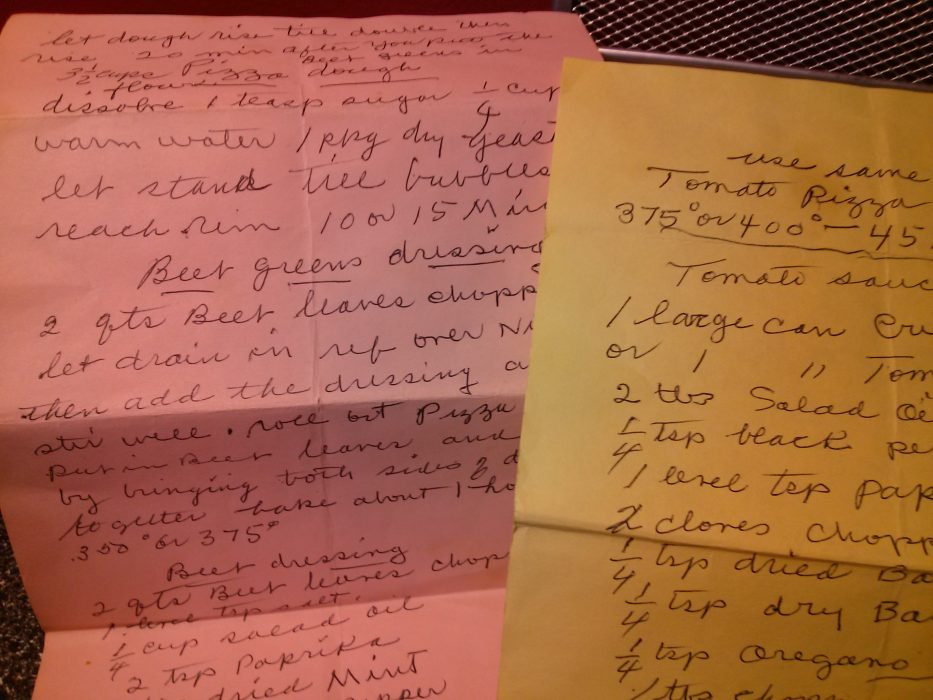Nonfiction
Annotation: A Recipe
Wobbly script on folded pages tucked into my recipe box along with a jumble of cards and clippings. Cheap paper torn from a notepad like the ones sold in grocery stores. One pink page, one yellow, the edges discolored. I never confuse this recipe with others. The fragmented lines carry me to my great-grandmother’s tidy […]
Wobbly script on folded pages tucked into my recipe
box along with a jumble of cards and clippings. Cheap paper torn from a notepad
like the ones sold in grocery stores. One pink page, one yellow, the edges
discolored. I never confuse this recipe with others. The fragmented lines carry
me to my great-grandmother’s tidy house on the hill, her low-ceilinged kitchen,
the stool with the slippery red seat and chrome legs, on which I, at the age of
eleven, sit and watch her knead dough for beet-green pizza.
I have asked her to teach me how.
The instructions are incomplete.
Pizza dough
3 ½ cups flour
dissolve 1 teasp sugar ¼ cup
warm water 1 pkg dry yeast
let stand till bubbles reach
rim 10 or 15 min
let dough rise til double then
rise 20 min after you put the beet greens in
She would have narrated each step as she jotted ingredients,
trusting I’d fill in the gaps. Or else she wrote it out another time and mailed
the pages to me. That part isn’t clear. What I know, years later, is that this
writing has shifted genre, from how-to into something more nuanced. Her recipe
has become an artifact imbued with biography. An object embodying a voice as
well as a taste.
Teresa Elizabeth DeSerio Possemato, born to immigrant
parents in 1900, still revered. Her pages can be read as code persisting through
time and geography. She never strayed far from home, but her recipe has.
Beet greens dressing
2 qts Beet leaves chopped
let drain in ref over Night
then add the dressing and stir
well. Roll out pizza dough
put in beet leaves and seal
by bringing both sides of
dough together bake about 1 hour
350⁰ or 375⁰
I love the play of the last line, with its embedded
shrug. 350 or 375—you decide. Most of her recipes, and mine, have no fixed
quantities. A handful of this, a sprinkle of that goes into bowl or pan. Adjust
according to how it looks or tastes or feels.
Beet-green pizza is typically made in early summer,
beet season. It was one her special foods, along with a sweet bread she baked at
Easter in the shape of baby dolls, a braid of dough swaddling a colored-egg
face. All the girls in the family got one, while the boys received a little
suitcase with the egg stuck in the middle like a bulging eye (but a good-angel protective
eye, not malocchio). Two things my great-grandmother
probably never knew about: gender-neutral toys and suitcases as symbols of
death. I still make the bread with my kids. Just the dolls, though, dolls for
everyone. We enact the tradition, adding an annual critique: it’s weird for a
child to carry a flour-dusted, fragrant doll around, play with it, and then
consume it, but I did that, and so did my children when they were small.
Unlike the Easter bread, beet-green pizza delivers a
complex load to the tongue—acrid, bitter, earthy, salty. Similar to a calzone, it’s
baked instead of fried, and the filling has no tomato sauce, just greens with a
bite of garlic and pepper. When I buy beets in the store, I look for the
freshest greens. The beets in my garden are grown for the tops, and if the roots
develop, that’s fine too.
Beet dressing
2 qts Beet leaves chopped
1 level tsp salt
¼ cup salad oil
2 tsp paprika
1 tbs dried Mint
1/8 tsp black pepper
2 cloves garlic chopped fine
½ cup seedless raisins (over)
we don’t get Beet leaves here
until May + June.
I use olive oil, not canola or corn. And I omit both raisins
and mint, because beet greens are a hard enough sell. In my adaptation the flavour
is flatter, tending toward a single savoury direction. My children won’t eat
beet-green pizza in any season or variation, but someday they will, I think.
For now I make it for myself, freezing portions to feed
relatives who understand the coded message, the unwritten annotation in the
margins of this recipe: homemade food equals I love you; I spend time on you. Depending on how hard the day or
how fraught the relationship, the message might be salted with a dash of guilt:
I sweated over this; be grateful.
Can the woman be reconstructed from her recipe? Any
portrait is slanted and incomplete; my small slice of experience coincided with
her old age; this is an unreliable recollection. Yet she lives large in the
minds of my clan—the aunts and cousins who grew to adulthood in the wingspan of
her care—and in the recipes we continue to make, compelled by a kind of faith.
When everyone who knew her is gone, she will pass from living memory. But not
yet. I remember her.
Seated on her couch in the front
room where she held court with frequent visitors, she could seem placid at
first, a pillow-pyramid of rolls rising to a small face with avid eyes and pursed
lips, ready for the obligatory two smacks, hello and goodbye. She wore her hair
pulled into a bun at the nape of her neck. I never saw it loose. Her skin was papery,
cross-hatched with fault lines, the kind of skin that bruises easily. She sat stolidly, feet encased
in black orthopedic shoes, stockings rolled below the knee, wearing a
housedress and cardigan, a tissue tucked in the sleeve. Her cane propped nearby. I recall her rolling out dough at the table in her kitchen, while I tried to balance
on the stool. She flipped the soft round disc, patted and pulled it, flour
rising around her fleshy wrists. The kitchen smelling of yeast. But more often,
I think of her sitting on that couch. She rarely left it in later years. Her
immobility belied a fierce energy for stories. She’d push herself forward, two
fists planted in the cushions for leverage, a paradox of soft and tough. She
had a high voice and a hooting laugh that shook her body. Gentle and mocking and
sometimes angry. A laugh that said, There’s nothing new under the sun. Strange
old world.
The couch, covered in thin blankets, sat across from
the TV playing the Catholic Mass for shut-ins on rotation. A pot nearby held an
enormous Christmas cactus, itself a shut-in for two months a year. She’d put it
in a closet to force blooms later, when it was brought back into the light. Cuttings
from that cactus were dispersed to far-flung relatives, and I have to believe
that cacti with genetic memory of the great-grandmother plant still grow today.
One time, discussing a granddaughter
who had just delivered her first baby and planned never to return to work,
Grandma Possemato said, “She’s not
going out to some office.” Spitting
the last word, a curse at female careerism combined with a slapped thigh of
emphatic approval. She was happy that her granddaughter would swim against the tide
of working mothers. Stay home and make beet-green pizza and other good Italian
dishes.
Later, in the murk of my own
careerism, I puzzled over this scrap of conversation. Grandma Possemato worked
both inside and outside the home, but that was necessary to provide for six
children she had to raise alone after being widowed at a young age. Her husband,
a railway worker, died in his thirties of a burst appendix. So she went out to cook
for another family. She kept her children together in defiance of relatives,
who pressured her to place them for adoption. She fed everyone through the
Depression and afterward.
Once she got talking about someone
she’d known long ago, a boy whose parents beat him constantly. “Nowadays they’d
call it child abuse, the way that poor fellow was used.” Her voice a lament, charged
with sorrow for harsh times, lost friends and chances. As people still do, she marked
the folly and brokenness of human nature and saw how change can blow up a stagnant society.
How new technology saves lives, turns appendicitis into a condition that rarely
kills.
There was conflict around her but not in her. She had
a stern (some said mean) mother and a rebel daughter. She raised my mother in
the aftermath of the rebel’s scandalous divorce. She fought the railroad for a
pension that never came, mounting a letter-writing campaign. Many years later,
when the company finally offered her a settlement, she refused it despite ongoing
poverty. She fought her battles, it seems, but I recall only her palpable
warmth, and the happiness of being accepted by her. That is the privileged
position of granddaughters who miss the main action by being born too late.
I have a picture of my
great-grandmother and me, taken at my wedding reception. For her to attend the
event required traveling to western New York, a few hours away by car. Not
owning a vehicle, not knowing how to drive, she went with relatives, carried
along the Thruway like an offering. Rousing herself from the couch was not a
gesture meant for me, I realized, but due entirely to her close relationship
with my mother, the little girl she’d sewn fancy dresses for and fed so well. At
eighty-eight she was the oldest guest and only surviving great-grandparent of
the bride and groom.
I stood behind her for the picture. A strand from her
bun caught in the beads of my wedding dress, and as I pulled away, I felt the
tug. It must have hurt her scalp, but she smiled for the photographer and
afterwards, I smoothed her hair.
Of her road trip, she later said: it was the first
time she’d slept in a hotel and the first time she’d eaten potato chips. Everyone
repeated that, laughing. Her cooking had always been from scratch, her life
untouched by convenience, but she relished new experiences.
Another photo, taken at a family
reunion a few years after Grandma Possemato died, shows four generations: my
grandmother, mom, me and my newborn daughter. I am holding my baby, surrounded
by mothers, one absent. All of us first-born girls, and bossy. All of us cooks,
but not just cooks.
We are more than the sum of our
recipes. I resist the essentialism of women as providers of nourishment. And
yet cooking is the lens through which I prefer to look back at my
great-grandmother. Food keeps a person alive, body and soul. When I make her
beet-green pizza, she is here.





